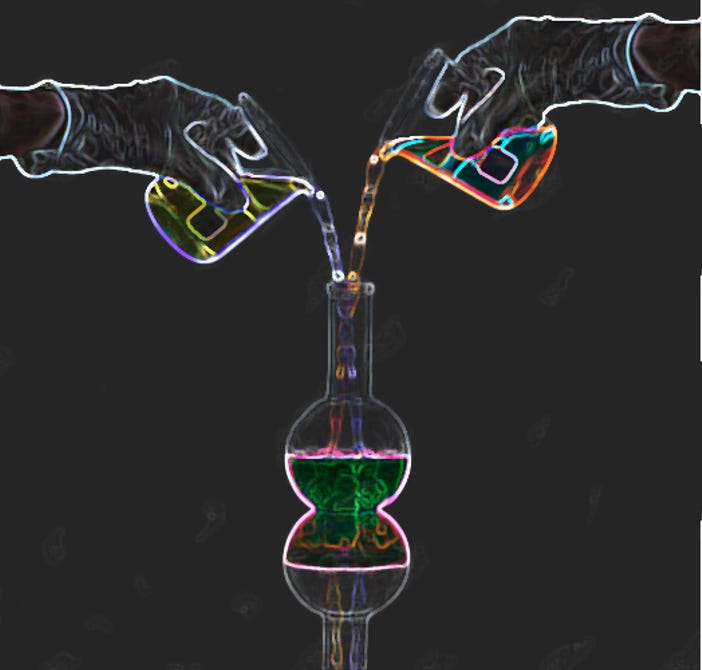Translation - Experimento
"Delira, delira, devorándome" = "Rave and rave, ravening me"
The following text is a text I wrote more than 10 years ago. I was finishing my studies as a literary translator and at some point we translated Samuel Beckett's Waiting For Godot. After I contrasted the French version with the English one, I came up with the idea that perhaps Beckett had merely translated himself into English and so I tried to do the same with one of my texts, originally written in Spanish.
The text itself is about a memory and just as memories are, it is diffuse. I remember I was in front of a pond with my best friend (at the time). He was a musician and we were talking about what he was into at the moment. This text sort of depicts the flow of both our thoughts intertwined as waves.
It was originally written in Spanish but when I translated it, it developed layers that were there but only became visible as I re-wrote it into English. In a way the marriage of both languages allowed me to give account of the moment with an exquisitively full detail as the meaning and re-expression of my experience got re-mirrored and thanks to this, expanded.
I called it Experimento.
.
----------------------------------------------
.
Delira y delira... Devorándome
Y creo que me acabaré devorando. Virtuosismo. “Su pensamiento era lineal; el de él, en cambio, se disparaba en diversas direcciones.” ¿Soy o no soy? ¿Qué es que sea? ¿Hay un mejor, un peor o sólo un diferente? Y si lo válido es lo real, y si lo válido es lo imaginario. El discurso poético aparece tan sugerente, tan adecuado, tan pertinente. Y el barroco y el regodeo: nudos y nudos para no caer en el sótano, en el va-cí-o del sótano. Y la pregunta por el hacer y la pregunta del para qué: forma y contenido. Luz-respuesta (provisional): 1) Forma: jugar y jugar en el imaginario o haciendo nudos, o provocando efectos en el otro. (Y desde ahí tu “¡me alegra(s)!” me basta todo); 2) Contenido: transcurso, recorrido… que pesa, que pesa (porque se piensa, y se piensa –se arrastra— consciencia) y se arrastra y se arrastra, pasado y presente, ¡tiempo! (se arrastra). Y es ir tejiendo fractales mientras se camina. Dejar ramas abiertas, arborescencias, que son como las gotas de un estanque que se pierden o se encuentran, unas con otras, y forman ecos y más reverberaciones. ¿Y si éstas llegan al infinito? ¿y si a ninguna rama se le priva de eco, de sonido? El resultado de la cópula es su con-tenido; el resultado de la cópula es su con-tenido.
And I think I might end up ending me –ravening me—. Virtuosity. “Its thought was linear; his pointed to different directions, instead.” Am I or am I not? ¿What is it that I am? ¿Is there a better, a worse, or just a divergent? And if the valid is the real, and if the valid is the imaginary. The poetic discourse appears so suggestive, so adequate, so pertinent. And the baroque and the re-going: knots and knots to prevent from falling deep into the vault, into the d-ee-p vault. And the question of the doing and the question of the why: form and content. Light-response (provisional): 1) Form: either play and play in the imaginary or making up knots, or provoking effects in the other. other (And from there your “[you] amuse/s/ me!” is at all enough for me); 2) Content: course, trail… that weighs, that weighs (‘cause I say, I say –‘tis dragged— conscience) and ‘tis dragged, and ‘tis dragged, past and future, time! (‘tis dragged). And it’s going twining fractals while walking. Leaving open leaves, arborescences, that are like tears, drops on a pond that fall apart, that come together, with one another, and that make echoes, reverberations. And what if they reach the infinite? ¿And what if one is deprived of echo, of sound? The copula’s result is content-ment; the copula’s result is content-ment.
Rave and rave… Ravening me
.
----------------------------------------------
.
[You can also find a live reading of the text on the following link (starting at minute 29:20): the recording of a conference I was invited to give on the problem of translation back in 2023 in the National University Autonomous of Mexico (UNAM).]


